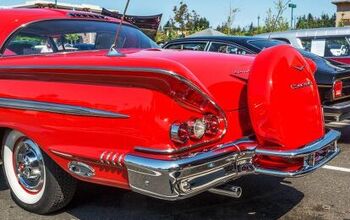QOTD: Are You Getting Away With Not Having Grip?

As I type this, the first flakes of this winter’s first real dumping of snow are falling lazily outside my window. By morning, the landscape should resemble the countertop in a Studio 54 bathroom. Then the real fun begins.
Carefully gauging your braking distance and leaving more room between your car and the car ahead, wondering all the while if that Rogue you can’t see around is hugging the back bumper of the car in front. Wondering what’s going to break loose first on a highway off-ramp — the front end or the rear. Trying to coax frozen wiper blades off the windshield without leaving the rubber strip behind. Downshifting at the top of hills. Trying to clear freezing rain off your windows without turning into William H. Macy in Fargo.
Never mind what happens in the ritzy ski lodges of Sweden and the Alps. Winter sucks. The only perk is it’s a lot easier to make a U-turn, assuming there’s no cops around and your vehicle’s e-brake isn’t of the electronic kind.
Depending on where you call home, you’ve probably switched your seasonal rubber by now. Or have you?
Maybe you should have made the switch, but didn’t. It might be a mild winter, you thought. After all, last year’s wasn’t so bad. You figure you can get away with it. Perhaps you’re living right on the meteorological border of “Why would anyone bother?” and “They’ll find me when spring rolls around.”
A few winters back, I ended up spending the “cold” season driving around with snow tires filling my trunk and backseat after the blizzards one would expect of the Great White North failed to materialize. With nature not fulfilling its end of the deal, they eventually headed back to the corner of the garage.
Maybe there’s no laws on the books in your frigid jurisdiction — and no money-saving clauses in your insurance policy — to make the switch worthwhile. This assumes, of course, complete confidence in your driving abilities and a fingers-crossed outlook on any incidents requiring rapid reaction that might crop up on the highway. This was my go-to plan for years: an old front-drive car, and a set of the cheapest all-seasons rotated front to back every year.
School’s not cheap, and adding two new tires each November worked year after year.
The clouds parted and the sun shone through when I finally bought my first set of Blizzaks. A revelation. I finally realized what I had been missing all those years. It was all the more timely, as that particular car, an ’03 Grand Am, “benefitted” from General Motors’ supremely horrible anti-lock brakes, seemingly carried over unchanged from a ’93 Corsica I owned years earlier. When the car detected a slippery surface, it “saved” its occupants by simply not trying to stop. Snow tires, and sometimes the added drag of a parking brake-induced sideways drift, came in real handy.
Why, GM, why?
But back to the question at hand. Do any of these scenarios ring a bell? Are you playing with fire this winter (and perhaps every winter) by not swapping your summer rubber? Why? And how much of the white stuff should a driver expect to tolerate before adding a set of snows to his or her life?

More by Steph Willems
Latest Car Reviews
Read moreLatest Product Reviews
Read moreRecent Comments
- 3-On-The-Tree Lou_BCone of many cars I sold when I got commissioned into the army. 1964 Dodge D100 with slant six and 3 on the tree, 1973 Plymouth Duster with slant six, 1974 dodge dart custom with a 318. 1990 Bronco 5.0 which was our snowboard rig for Wa state and Whistler/Blackcomb BC. Now :my trail rigs are a 1985 Toyota FJ60 Land cruiser and 86 Suzuki Samurai.
- RHD They are going to crash and burn like Country Garden and Evergrande (the Chinese property behemoths) if they don't fix their problems post-haste.
- Golden2husky The biggest hurdle for us would be the lack of a good charging network for road tripping as we are at the point in our lives that we will be traveling quite a bit. I'd rather pay more for longer range so the cheaper models would probably not make the cut. Improve the charging infrastructure and I'm certainly going to give one a try. This is more important that a lowish entry price IMHO.
- Add Lightness I have nothing against paying more to get quality (think Toyota vs Chryco) but hate all the silly, non-mandated 'stuff' that automakers load onto cars based on what non-gearhead focus groups tell them they need to have in a car. I blame focus groups for automatic everything and double drivetrains (AWD) that really never gets used 98% of the time. The other 2% of the time, one goes looking for a place to need it to rationanalize the purchase.
- Ger65691276 I would never buy an electric car never in my lifetime I will gas is my way of going electric is not green email


































Comments
Join the conversation
I remember dad's second Passat had an awful ABS like that, the winter prep was basically after the first bent bumper: winter tires + pull the ABS fuse.
I would like to point out that I've never seen such a basic Tundra in real life.